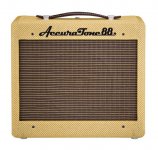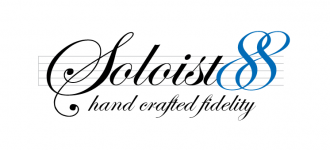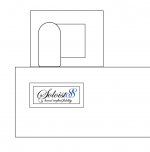Gak!😱 Yes!😎
Might be okay for a 50's guitar amp (in Tweed with a tremolo knob and spring reverb).
..Todd
😀

Good catch!
Last edited:
I'm only a lurker here but I'd like to give a suggestion for the name, so how about "soloist 88"? Google search didn't turn up anything.
I'm only a lurker here but I'd like to give a suggestion for the name, so how about "soloist 88"? Google search didn't turn up anything.
I like it!
The more I played with it, the more I liked the name. Soloist has a subtle implication of being a monoblock channel standing alone. You will need 2 Soloist 88's playing a duet though. 😎
Here's my graphic interpretation:
Here's my graphic interpretation:
Attachments
Last edited:
mmmm
isnt the G key last loop in the wrong sense?
It should go to the left and that may even be nicer.
sorry...
anyway, nice logo.
isnt the G key last loop in the wrong sense?
It should go to the left and that may even be nicer.
sorry...
anyway, nice logo.
Here's one way you can apply the logo to an amplifier...
Create a 'badge frame' somehow, using the same wood than is used on the chassis, or possibly aluminum, or plastic, or whatever. You might even be able to find a suitable frame on some scrap appliance if you look hard enough.
Print the logo on glossy photo paper, it will come out much sharper and vivid than if you used plain paper. I've attached a high resolution (vector based) logo sheet. Just print it out and choose the appropriate logo size. If you somehow convert this to a bitmap image (no longer vector based) I recommend you create it at 300-500% of its final size and somehow scale it back down to 33-20% at print time to 'concentrate' the resolution. PM me if you need help with that.
Find some self-adhesive clear label material from an office supply store and apply a large piece over the logo to provide a glossy, protective coating. Apply another clear label to the back of the logo to provide some heft and keep the glue from seeping through. Cut the logo out to exactly fit into your frame using a razor knife and a straight-edge, and glue it in using a small amount of whatever glue will stick well to your frame material.
Another tip: Always leave some 'white space' around the logo so it fits comfortably in the frame. The lettering should not touch the frame, or even come close. The diagram shows a decent 'white space' margin.
See diagram and logo sheet attached.
..Todd
Create a 'badge frame' somehow, using the same wood than is used on the chassis, or possibly aluminum, or plastic, or whatever. You might even be able to find a suitable frame on some scrap appliance if you look hard enough.
Print the logo on glossy photo paper, it will come out much sharper and vivid than if you used plain paper. I've attached a high resolution (vector based) logo sheet. Just print it out and choose the appropriate logo size. If you somehow convert this to a bitmap image (no longer vector based) I recommend you create it at 300-500% of its final size and somehow scale it back down to 33-20% at print time to 'concentrate' the resolution. PM me if you need help with that.
Find some self-adhesive clear label material from an office supply store and apply a large piece over the logo to provide a glossy, protective coating. Apply another clear label to the back of the logo to provide some heft and keep the glue from seeping through. Cut the logo out to exactly fit into your frame using a razor knife and a straight-edge, and glue it in using a small amount of whatever glue will stick well to your frame material.
Another tip: Always leave some 'white space' around the logo so it fits comfortably in the frame. The lettering should not touch the frame, or even come close. The diagram shows a decent 'white space' margin.
See diagram and logo sheet attached.
..Todd
Attachments
Last edited:
mmmm
isnt the G key last loop in the wrong sense?
It should go to the left and that may even be nicer.
Good eye, but that's done on purpose. The descending stroke is arching toward a reverse (right) flourish, as used on a treble clef which helps to tie in the musical notation theme, and using a reverse flourish better involves the tag line text by moving towards it rather than away from it.
..Todd
Back to electronics, and the BoM in particular...
BW, did you have any specific 2.5H choke models in mind that we should list in the BoM, or let folks fend for themselves.
And speaking of fending, finding a large source for the 500V power supply caps isn't easy. Both Digi-key and Mouser only have a few odds and ends in stock. I suspect folks will need to shop at overpriced boutique stores (or eBay) for these. Unless someone knows a suitable supplier we can list.
..Todd
BW, did you have any specific 2.5H choke models in mind that we should list in the BoM, or let folks fend for themselves.
And speaking of fending, finding a large source for the 500V power supply caps isn't easy. Both Digi-key and Mouser only have a few odds and ends in stock. I suspect folks will need to shop at overpriced boutique stores (or eBay) for these. Unless someone knows a suitable supplier we can list.
..Todd
Last edited:
Yes I found finding 500V power supply caps very hard at the start of this thread.
HV PS caps can be Panasonic TS-UPs
Choke is a Hammond 159T
Hash choke , Eli said JW miller Mouser stock # 542-5800-152-RC
I don't know how to judge the best resistors for the PS. Wirewound? Ceramic? Other?
For my build, i'll use SCHOTTKY 1200V 5A TO220-2 for B+, and cheaper low volt. SCHOTTKY's for bias.
Looking at Russian teflon for coupling, but this is still up in the air. Undecided still.
Circuit resistors? Dale Vishay? Who knows?
HV PS caps can be Panasonic TS-UPs
Choke is a Hammond 159T
Hash choke , Eli said JW miller Mouser stock # 542-5800-152-RC
I don't know how to judge the best resistors for the PS. Wirewound? Ceramic? Other?
For my build, i'll use SCHOTTKY 1200V 5A TO220-2 for B+, and cheaper low volt. SCHOTTKY's for bias.
Looking at Russian teflon for coupling, but this is still up in the air. Undecided still.
Circuit resistors? Dale Vishay? Who knows?
Last edited:
Find some self-adhesive clear label material from an office supply store and apply a large piece over the logo to provide a glossy, protective coating. Apply another clear label to the back of the logo to provide some heft and keep the glue from seeping through.
Or just print on glossy photo paper as instructed, then run the "photo" through a laminator. A friend who builds analog music synthesizers used this technique on his ARP 2600 clone. The entire front panel is made from laminated "photos" over aluminum sheet. Pictures here:
electro-music.com :: View topic - DIY ARP-2600 Modular Synthesizer
HV PS caps can be Panasonic TS-UPs
Yeah, but where to get them? DK and Mouser don't stock many values.
The smaller values are easy enough to find as Sprague Atoms, but not the 100uF+ values.
JEA capacitors on eBay has some TDI 330uF/500V caps (good qty discount if you buy 25).
..Todd
Last edited:
There is a pervasive problem of parts not being in stock combined with lengthy wait times. 😡 It's yet another effect of the Little Depression.
Allied stock # 541-2461 is a Kemet part, which will fill the 500 WVDC/330 μF. need, but (you guessed it) the on hand quantity is zero.
Allied stock # 541-2461 is a Kemet part, which will fill the 500 WVDC/330 μF. need, but (you guessed it) the on hand quantity is zero.
BW, did you have any specific 2.5H choke models in mind that we should list in the BoM, or let folks fend for themselves.
And speaking of fending, finding a large source for the 500V power supply caps isn't easy. Both Digi-key and Mouser only have a few odds and ends in stock. I suspect folks will need to shop at overpriced boutique stores (or eBay) for these. Unless someone knows a suitable supplier we can list.
..Todd
TubeMack is correct, the choke is a Hammond 159T; 2.5H 300ma, 43 ohm R.
Interesting, I've been buying the TS-UP's from DigiKey without issue. I have not bought any in a few months, though. You could always series stack TS-HA's or TS-HB's. The TS-HA's max out at 400V and the TS-HBs max out at 450V. Digikey is presently stocking the TS-HA's and TS-HB's.
For C1, you could use 2X 400V Pana TS-HA's 270u, and for C2 2X 400V TS-HA's 470u, each pair series wired with 220K R resistors across each cap to assure proper voltage sharing. This setup would allow plenty of voltage headroom, even at cold start.
Last edited:
And speaking of fending, finding a large source for the 500V power supply caps isn't easy.
If you have the chassis space I would suggest a big (physically) motor run cap 80 to 100uF 370 VAC (over 500 VDC) in parallel with a more reasonably sized electrolytic (220 uF if you want). You will wind up with a lower ESR and a lower ESL than a single cap, or two identical caps in parallel, which means a lower impedance power supply over a wider frequency range.
Most Simple SE builders, including myself use a 80 to 100 uF motor run (polypropelyne film) cap (Midori Meadows on Ebay) and a 120 uF 500 V Panasonic electrolytic (Digikey P7451-ND) in parallel. Everyone reports better sound dynamics than the electrolytic alone. I use the same combo in my P-P amp, except for the monster 600uf 500V film caps some of us scored on Ebay. They work great all by themselves.
As said before I suffer from over-exposure here ... so might as well carry on! 🙂
The 'badge':
I did not at first see the 'S' as a musical symbol (although I have such a background) - meaning that the observer's 'eye + mind' might lock on to a letter + the rest of the name immediately before noticing the musical stave. To me the logo appeals strongly as is.
Regarding those 'now-in-stock-now-not' capacitors; I thought it was only us South Africans down below here (with apology to the Ozzies) who had that problem. Perhaps because of that, but certainly also because I (and we down here) can see no problem in stacking electrolytic capacitors, I have resorted to that, and to dispell the uncomfortable (paranoid?) feeling of working things at their maximum. I certainly sleep better by using say two 470µF 350V capacitors in series (with necessary dividing resistors). It also leaves a wider choice of products - even boutique products for whose pleasure it is.
Then one gets quite superior products these days. Again, perhaps having shed some 'old school' garb, I can really not find a reason for ultra-low ESR - better than a quality electrolytic + poly(whatever) cap in parallel can provide. If someone feels happier with huge motor caps - it is his money. (I grew up with snakes - frightened the hell out of me; hate them and anything to do with them.)
The 'badge':
I did not at first see the 'S' as a musical symbol (although I have such a background) - meaning that the observer's 'eye + mind' might lock on to a letter + the rest of the name immediately before noticing the musical stave. To me the logo appeals strongly as is.
Regarding those 'now-in-stock-now-not' capacitors; I thought it was only us South Africans down below here (with apology to the Ozzies) who had that problem. Perhaps because of that, but certainly also because I (and we down here) can see no problem in stacking electrolytic capacitors, I have resorted to that, and to dispell the uncomfortable (paranoid?) feeling of working things at their maximum. I certainly sleep better by using say two 470µF 350V capacitors in series (with necessary dividing resistors). It also leaves a wider choice of products - even boutique products for whose pleasure it is.
Then one gets quite superior products these days. Again, perhaps having shed some 'old school' garb, I can really not find a reason for ultra-low ESR - better than a quality electrolytic + poly(whatever) cap in parallel can provide. If someone feels happier with huge motor caps - it is his money. (I grew up with snakes - frightened the hell out of me; hate them and anything to do with them.)
YOu may want to try www.tenfourltd.com. May have to call them as their web site is not easy to get through. I've been in there and have all kinds of caps. Nice local supplier
- Home
- Amplifiers
- Tubes / Valves
- Mullard 5-20 KT88 PP blocks!


